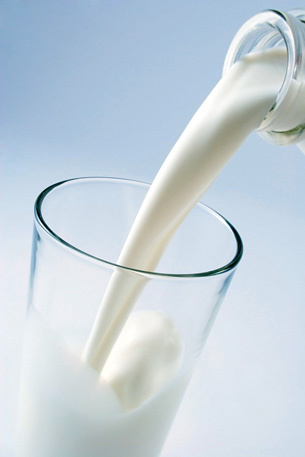Module 7
1. Module 7
1.9. Lesson 3
Module 7—Molecular Genetics: DNA, RNA, and Protein Synthesis
Lesson 3—Protein Synthesis

© Olga Lyubkina/shutterstock
 Get Focused
Get Focused
Have you got milk “issues”? Can’t eat or drink some dairy products? Many people are not able to consume dairy products, which contain lactose. One reason for lactose intolerance is the inability to produce the enzyme lactase needed to digest the sugar lactose found in milk. From Biology 20, you recall that enzymes are protein molecules. Another function of DNA is its role in protein synthesis.
Although we have the genetic code, the instructions on our chromosomes must also be expressed. The genes found on our chromosomes code for proteins that are needed for our survival. Humans cannot survive without proteins. Proteins are the basis of our structure and contribute to the formation of cell membranes, muscles, bones, and hair. As you have studied, proteins also serve a functional role in antibodies, enzymes, and hormones. For example, the functional role of lactase is the digestion of lactose.
The gene for lactase and the formation of other proteins is expressed through a process called protein synthesis. When humans can’t make certain proteins, like lactase resulting in lactose intolerance, then structures or functions can be affected.
lactase: an enzyme involved in the digestion of lactose
gene: a specific sequence of DNA that encodes a protein, tRNA, or rRNA, or that regulates the transcription of such a sequence
protein synthesis: amino acids forming larger protein molecules under the direction of DNA
protein: organic macromolecule assembled from subunits of amino acids
In this lesson you will learn how DNA has the genetic code for and directs the synthesis of proteins. You will discover the different types of RNA and the roles they play in the synthesis of proteins. In Lesson 4 you will discover the types of mistakes that can be made in protein synthesis and the consequences to the body’s structures and functions.
But what would happen if humans could make extra proteins, ones that are not part of the genetic code? Could humans develop the ability to make silk, as Spiderman does? Scientists have developed technologies for transferring genes from one organism to another. As you will discover later in this lesson when you read about some goats in Quebec, these genes are expressed and give the host organism some interesting qualities.
This lesson will address the following focusing question:
- How is the genetic code in DNA copied and used to assemble amino acids into proteins?
 Module 7: Lesson 3 Assignment
Module 7: Lesson 3 Assignment
Your teacher-marked Module 7: Lesson 3 Assignment requires you to submit a response to the following:
- questions on a RNA and protein synthesis simulation
- “Thought Lab 18.2: Transcription in Reverse” on page 639 of the textbook
Download a copy of the Module 7: Lesson 3 Assignment to your computer now. You will receive further instructions about how to complete this assignment later in the lesson.
You must decide what to do with the questions that are not marked by the teacher.
Remember that these questions provide you with the practice and feedback that you need to successfully complete this course. You should respond to all of the questions and place those answers in your course folder.
You have the option of trying additional questions from the textbook for further practice. Consult with your teacher for the answers to these questions. The Key will also provide you with many Diploma Exam-style multiple-choice, numerical-response, and written-response questions that will be an excellent review of the module. Practising your responses to these types of questions is good preparation for the Diploma Exam.